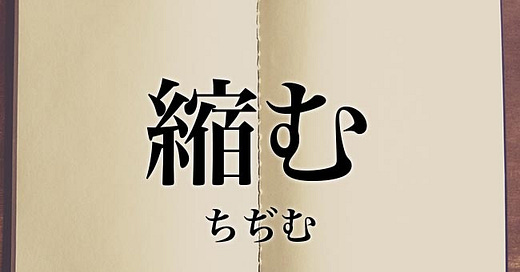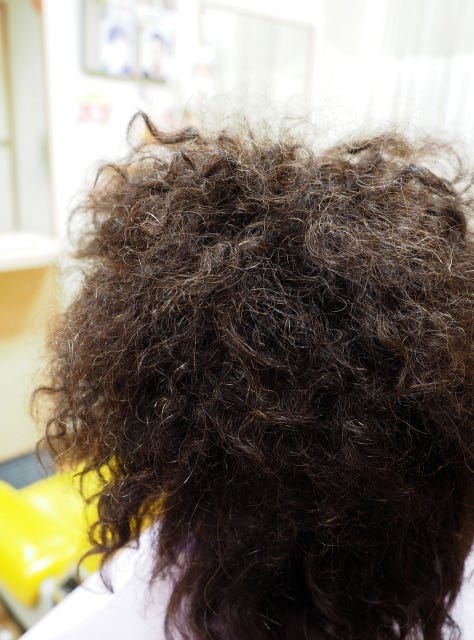"chijimu": , shortening, shrinking, reducing, contracting, scrunching, wrinkling, shriveling
Now that we’ve learned the all-purpose word nobiru, for growing, stretching, smoothing, extending, and spreading, let’s take a look at its opposite: chijimu.
It’s uncanny how precisely chijimu mirrors nobiru. For each and every nuance of nobiru, chijimu provides the opposite. If nobiru lengthens something, chijimu shortens it. If nobiru smooths something out, chijimu wrinkles it back up again. If nobiru expands, chijimu shrinks. If nobiru extends, chijimu reduces.
Like nobiru, chijimu can apply to space, time, and abstract concepts.
Today’s lesson in kana usage
Note that if you need to write chijimu in hiragana, it’s ちぢむ, not ちじむ. This follows the rules of official modern kana usage (現代かなづかい, gendai kana-zukai), the third principle of which is:
ぢ,づはじ,ずと書く。……ただし(1)二語の連合によって生じたぢ,づは,ぢ,づと書く。」例えば「はなぢ」というのは「鼻」と「血」の二語の連合である。「三日」の「月」で「みかづき」である。こういうが二語の連合。
Which says, “ぢ (di) and づ (du) are written as じ (ji) and ず (zu). However, (1) ぢ and づ arising from two words being combined are written as ぢ and づ. For example, the word はなぢ/hanaji for nosebleed is a combination of the two words 鼻/hana/nose and 血/chi/blood. 三日/mika/third day and 月/tsuki/month combine to form みかづき/mikazuki/crescent moon. This is two words being combined.”
However, in the case of 縮む there is a different rule which applies:
それから「(2)同音の連呼によって生じたぢ,づは,ぢ,づと書く。」例えば「ちぢむ(縮む)」「つづく(続く)」は,「ち」に続く「ぢ」だから「ぢ」,「つ」の次にくるから「づ」というふうに書く,こういう規定がある。
Which says, “Continuing, (2) ぢ (di) and づ (du) resulting from a repetition of the same sound are written as ぢ (di) and づ (du). For example, in the case of ちぢむ (縮む, chijimu, shrink) and つづく (続く, tsuzuku, continue), the ぢ follows a ち so it’s ぢ, and the づ follows a つ so it’s づ.”
Another example is つづる (tsuzuru) which is written 綴る in kanji and means to spell.
Does any of this matter? For one thing, depending on your IME (input method), it could require you to type in “chidimu” and refuse to convert “chijimu” correctly.
Kanji
In kanji, chijimu is written 縮む, of course. That’s a classic phono-semantic compound, with the thread (糸) on the left providing the meaning (after all, threads are something that can get tangled up), and the 宿 on the right the phonetic value—think 新宿 (Shinjuku). This character is used in familiar compounds like asshuku (圧縮, compress—this is the word used for compressing computer data), shukushō (縮小, cut back), 収 縮 (shūshuku, deflate ), and shinshuku (伸縮, growing and shrinking, in other words, behaving elastically, or scaling). There are many more, including some very common and useful ones.
If you still need convincing that chijimu is about more than just getting a reduction in length, consider 縮毛 (shukumō kōsei, curly or kinky hair); fixing that would be 縮毛構成 (hair straightening).
And we just have to mention 恐縮 (kyōshuku), meaning being sorry for troubling someone, often used before a request. What could that possibly have to do with shrinking? Well, obviously you’re shrinking back in fear.
Some variations on chijimu
Some new students of Japanese might not have seen the reading 縮れる, chijireru. The meaning is closely related to chijimu. Basically, it means frizzy. tightly curled, or wavy hair, or something that is crinkled, like a wad of paper. If your hair is like this, you could call it ちりちり (chiri-chiri), or use 縮れ毛 (chijire-ge). The word chijimu can be used in this meaning too!
If you shrink your whole body down into to a curled-up shape, or are squeezing in somewhere, that would be 縮こまる (chijikomaru).
You can also say 縮まる/chijimaru, but this is extremely close in meaning, if not identical, to plain old chijimu.
Next steps
In case you were wondering, we’re examining chijimu because that’s what Komako’s lips were doing in Kawabata’s Yukiguni; actually, they were doing nobi-chijimi. Seidensticker thinks that meant “opening and closing”. But that’s starting to look less and less likely. Stay tuned.





